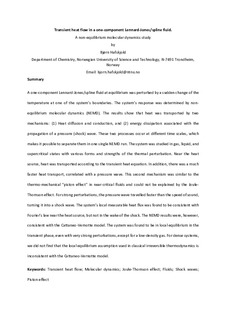Transient Heat Flow in a One-component Lennard-Jones/spline Fluid. A Non-equilibrium Molecular Dynamics Study
Journal article
Submitted version
Permanent lenke
http://hdl.handle.net/11250/2490062Utgivelsesdato
2017Metadata
Vis full innførselSamlinger
- Institutt for kjemi [1390]
- Publikasjoner fra CRIStin - NTNU [37963]
Originalversjon
Computational methods in science and technology. 2017, 23 (3), 185-198. 10.12921/cmst.2017.00000012Sammendrag
A one-component Lennard-Jones/spline fluid at equilibrium was perturbed by a sudden change of the temperature at one of the system’s boundaries. The system’s response was determined by non-equilibrium molecular dynamics (NEMD). The results show that heat was transported by two mechanisms: (1) Heat diffusion and conduction, and (2) energy dissipation associated with the propagation of a pressure (shock) wave. These two processes occur at different time scales, which makes it possible to separate them in one single NEMD run. The system was studied in gas, liquid, and supercritical states with various forms and strengths of the thermal perturbation. Near the heat source, heat was transported according to the transient heat equation. In addition, there was a much faster heat transport, correlated with a pressure wave. This second mechanism was similar to the thermo-mechanical “piston effect” in near-critical fluids and could not be explained by the Joule-Thomson effect. For strong perturbations, the pressure wave travelled faster than the speed of sound, turning it into a shock wave. The system’s local measurable heat flux was found to be consistent with Fourier’s law near the heat source, but not in the wake of the shock. The NEMD results were, however, consistent with the Cattaneo-Vernotte model. The system was found to be in local equilibrium in the transient phase, even with very strong perturbations, except for a low-density gas. For dense systems, we did not find that the local equilibrium assumption used in classical irreversible thermodynamics is inconsistent with the Cattaneo-Vernotte model.
